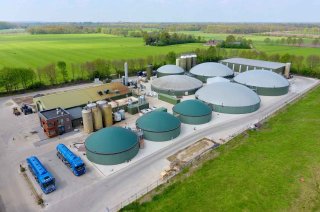
Project
SYSTEMIC: Circular solutions for biowaste and manure
The EU-project SYSTEMIC will demonstrate economically viable business cases for nutrient recovery from biowaste, animal manure and sewage sludge. It will contribute to the expansion of nutrient recovery across the European Union and thereby facilitate the move to a more circular economy.
Nitrogen, phosphorus and potassium are crucial for plant growth. In the EU, half of the phosphorus and nitrogen applied annually to croplands is derived from non-renewable sources such as phosphate rock or is produced by processes which consume large amounts of fossil fuels like natural gas. In our present system, a high percentage of valuable nutrients are lost through the incineration or disposal of waste (like organic matter and nitrogen) or through emissions of nutrients to the environment which causes eutrophication problems (nitrogen and phosphorus enrichment of waters).
These inefficiencies in the system, combined with population growth and the enlargement of the livestock sector, are having severe effects on soil, air and water quality and threatening the long-term sustainability of EU agriculture. The recovery and reuse of nutrients from bio-waste, animal manure, and sewage sludge can help to turn this situation around.
SYSTEMIC will contribute to reducing the reliance on non-renewable resources, lower greenhouse gas emissions, reducing soil, air and water pollution by using fertilisers which meet with the crop requirements (rather than the direct spreading of organic residues), and helping livestock farmers and urban centres to manage their waste.
Demonstration of nutrient recovery and reuse
The project focussed on five anaerobic digesters were owners invested in full-scale technologies for recovery of nutrients from digestate. The goal was to produce biobased fertilising products meeting demands of regional farmers thereby reducing costs for digestate handling and disposal. The reports give a detailed overview of the technical aspects, mass- and energy balances and quality of the biobased fertilising products.
- Factsheets of five large-scale anearobic digesters applying nutrient recovery and reuse
- Technical performance and mass- and energy balances of five large-scale anearobic digesters applying nutrient recovery and reuse (Brienza et al., 2021)
- Evaluation of five anaerobic digesters applying nutrient recovery and reuse (Regelink et al., 2021)
- Video – Groot Zevert Vergisting (Netherlands). RENURE fertilisers from digestate
- Video- AmPower (Belgium) – Biowaste as a feedstock for biogas and biobased fertilisers
- Video – Waterleau New Energy (Belgium) – Biowaste as raw material for the production of mineral ammonium water and organic fertilisers.
- Video – Acqua & Sole (Italy) – Sewage sludge as resource for organic and mineral fertilisers
- Video – BENAS (Germany) – Energy crops as resource for mineral N and organic fibres
Business case analysis
The project made an assessment of the economics of the central biogas plants including the production and sale of biobased fertilisers. A tool has been developed allowing other plant owners to quickly calculate their economic Key Performance Indicators (KPIs) and compare these with other plant owners.
- Report on regulations governing anaerobic digesters and nutrient recovery and reuse in EU member states (Hermann et al., 2020)
- Business case evaluation of five centralised anearobic digesters applying nutrient recovery and reuse (Hermann et al, 2021)
- Application of economic key performance indicators to five centralised anearobic digesters (Hermann et al, 2021)
- Development of business models for six large-scale anearobic digesters (Hermann et al, 2021)
- KPI-tool voor analyse van de economische prestaties van vergisters
Quality of biobased fertilising products
Biobased fertilising products were tested in lab- and fieldtrials to assess the agronomic effectiveness as well as losses to the environment. In addition, an life-cycle-analysis (LCA) was set up to assess the impact of anaerobic digestion in combination with nutrient recovery on greenhouse gas emissions.
- Product composition and performance in lab- and field trials for biobased fertilisers and soil improvers recovered from digestate (Sigurnjak et al., 2021)
- Assessment of environmental impacts upon application of biobased fertilising products recovered from digestate (Schoumans et al., 2021)
- Sustainability assessment of five large-scale anaerobic digesters employing nutrient recovery and reuse technologies (Hermann et al., 2021)
Opportunities for other biogas plants
SYSTEMIC also explored opportunities for ten other biogas plants that were spread over Europe treating different types of feedstock. Detailed information and opportunities for nutrient recovery are presented in the deliverables below.
- Factsheets of ten biogas plants that participated in the SYSTEMIC project as outreach location.
- Scenario's and schemes of proven techniques for digestate treatment and nutrient recovery (Verbeke te al., 2021)
- Market study for biobased fertilising products within a European context (Verbeke et al. ,2021)
- Business Development package for nutrient recycling at anaerobic digester including manual and guiding materials (Verbeke et al., 2021)
NutriCas Tool
This tool enables the user to easily calculate the amount and composition of biobased fertilising products for a number of different technical solutions and a given composition of the digestate. The tool also gives an estimate of the investment costs and operational costs.
SYSTEMIC policy advice
The project team formulated several advices for policy makers to facilitate the transition towards a circular economy for nutrients.